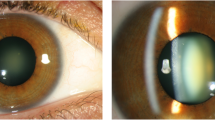Abstract
NR is a 52-year-old moderately myopic man who noted the onset of flashes of light several weeks prior to presentation at his ophthalmologist’s office. He experienced numerous little black floaters and clouding of his vision in the left eye on the morning of the consultation. Examination found vision 20/20 OD and 20/100 OS. Fundus examination was normal in the right eye, and no fundus detail could be observed in the left because of a moderately dense vitreous hemorrhage. The patient was advised to stop taking aspirin products, minimize physical activity, and return for follow- up in 2 weeks. However, he was very bothered by the lack of vision in his left eye and sought a second opinion from a retinal specialist.
This chapter contains video segments that can be found by accessing the following link: http://www.springerimages.com/videos/978-1-4614-7081-6.
You have full access to this open access chapter, Download chapter PDF
Similar content being viewed by others
Keywords
These keywords were added by machine and not by the authors. This process is experimental and the keywords may be updated as the learning algorithm improves.
NR is a 52-year-old moderately myopic man who noted the onset of flashes of light several weeks prior to presentation at his ophthalmologist’s office. He experienced numerous little black floaters and clouding of his vision in the left eye on the morning of the consultation. Examination found vision 20/20 OD and 20/100 OS. Fundus examination was normal in the right eye, and no fundus detail could be observed in the left because of a moderately dense vitreous hemorrhage. The patient was advised to stop taking aspirin products, minimize physical activity, and return for follow- up in 2 weeks. However, he was very bothered by the lack of vision in his left eye and sought a second opinion from a retinal specialist.
B-scan demonstrated a moderately dense vitreous hemorrhage and a total PVD with a focal area of vitreoretinal traction inferio-temporally (Fig. 1). The diagnosis of a flap tear with traction was made, and the patient was instructed to elevate his head at night and to return the next day for reexamination. The plan was to treat the tear with laser as soon as the blood cleared enough to allow visualization or plan vitrectomy with endolaser if the blood remained and the retina showed evidence of detaching. By the third day, the blood had settled enough to allow placement of laser spots around the tear, and the retina remained attached.
Detachment of the vitreous occurs commonly in individuals past the age of 40, and 6–15 % of patients with symptoms of flashes and floaters with a PVD will experience a retinal tear as part of this process [4]. The average practitioner will usually see at least one patient a day with a PVD. These individuals should be examined with indirect ophthalmoscopy and scleral depression and then followed up within a few weeks. They can be informed that the floater will become less noticeable over time.
A number of people experience only syneresis of the vitreous gel resulting in one or more floaters without a detachment of the vitreous. They sometimes present with complaints of a floater that can be quite concerning to them. Demonstration of the opacity on B-scan and the explanation that it is nonthreatening to the eye can be reassuring to the patient.
References
Boldrey EE. Risk of retinal tears in patients with vitreous floaters. Am J Ophthalmol. 1983;96:783–7.
Author information
Authors and Affiliations
Electronic Supplementary Material
PVD and vitreous hemorrhage (WMV 22.8 MB)

Video clip D JPEG PVD and vitreous hemorrhage
Arrow: posterior vitreous face (JPEG 92.9 KB)
Rights and permissions
Copyright information
© 2014 Springer Science+Business Media New York
About this chapter
Cite this chapter
Harrie, R.P., Kendall, C.J. (2014). Case Study 7 Posterior Vitreous Detachment and Retinal Tear. In: Clinical Ophthalmic Echography. Springer, New York, NY. https://doi.org/10.1007/978-1-4614-7082-3_7
Download citation
DOI: https://doi.org/10.1007/978-1-4614-7082-3_7
Published:
Publisher Name: Springer, New York, NY
Print ISBN: 978-1-4614-7081-6
Online ISBN: 978-1-4614-7082-3
eBook Packages: MedicineMedicine (R0)





